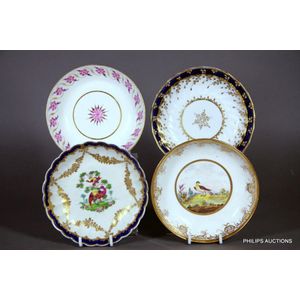Minton Bone China Display Plates (Set of Three)
You must be a subscriber, and be logged in to view price and dealer details.
Subscribe Now to view actual auction price for this item
When you subscribe, you have the option of setting the currency in which to display prices to $Au, $US, $NZ or Stg.
- Bone China - Bone china, Also called 'English china", is one of the three types of porcelain, the other two being soft paste porcelain and hard paste porcelain.
Porcelain is an ancient ceramic material, first made in China, hence the common name "china", and the introduction of bone china was to counter the imports of Chinese porcelain.
The initial development of bone china is credited to Josiah Spode, who introduced it around 1800 and it was soon after copied by other manufacturers including Minton, Coalport, Davenport, Derby, Worcester, Wedgwood and Rockingham and the Herculaneum factory at Liverpool.
Spode's bone china was made by mixing ash from cattle bones with feldspar and kaolin, which created a material that was stronger, more translucent, and whiter than traditional porcelain. He began to produce this new type of porcelain in 1796 and it quickly became very popular.
At the time, the process and ingredients were kept secret and were only known to a few manufacturers and were protected by patents.
In the 19th century, bone china became increasingly popular and was widely produced by many manufacturers in England. During this time, it was considered a luxury item and was often used to create fine dining sets and other decorative items.
Bone china is still used in the production of fine porcelain wares, such as tea sets, figurines, and other decorative pieces. His basic formula of six parts bone ash, four parts china stone, and three and a half parts china clay remains the standard English body. It is still considered a luxury item due to its strength, translucency, and whiteness, and is often used for high-end and high-quality porcelain. China.
This item has been included into following indexes:
- Mintons Ltd. (England), items
Visually similar items

Five English Delft plates, circa 1690-1760 including a coronation plate with crowned bust of William III with two tulips in blues, green and yellows, a Bristol Delft plate in Chinese design of man with fan under a tree within a panelled brocade border, and

Four saucers by Chamberlain Worcester, Pinxton, circa 1780s-1810, two items unmarked, a Chamberlain Worcester shanked saucer pattern N.66; a Worcester fluted bowl with a fancy bird, crescent mark underside and an unmarked Worcester saucer; a Pinxton saucer

18ct gold and diamond ring, Kenneth Mansergh, 1991, of foliate design, collet-set with an oval-cut diamond weighing 1.61 carats flanked by a similarly set round brilliant-cut diamond weighing 0.99 and 0.96 carats respectively, size P, signed KM for Kenneth

German gold hunting case pocket watch, 14ct yellow gold case, lever movement, white enamel dial with applied Arabic numbers, subsidiary seconds, cased marked '14k 0585 56', with Crown in a circle, the front lid engraved 'E H, diameter 5 cm weight 71.3 gram
